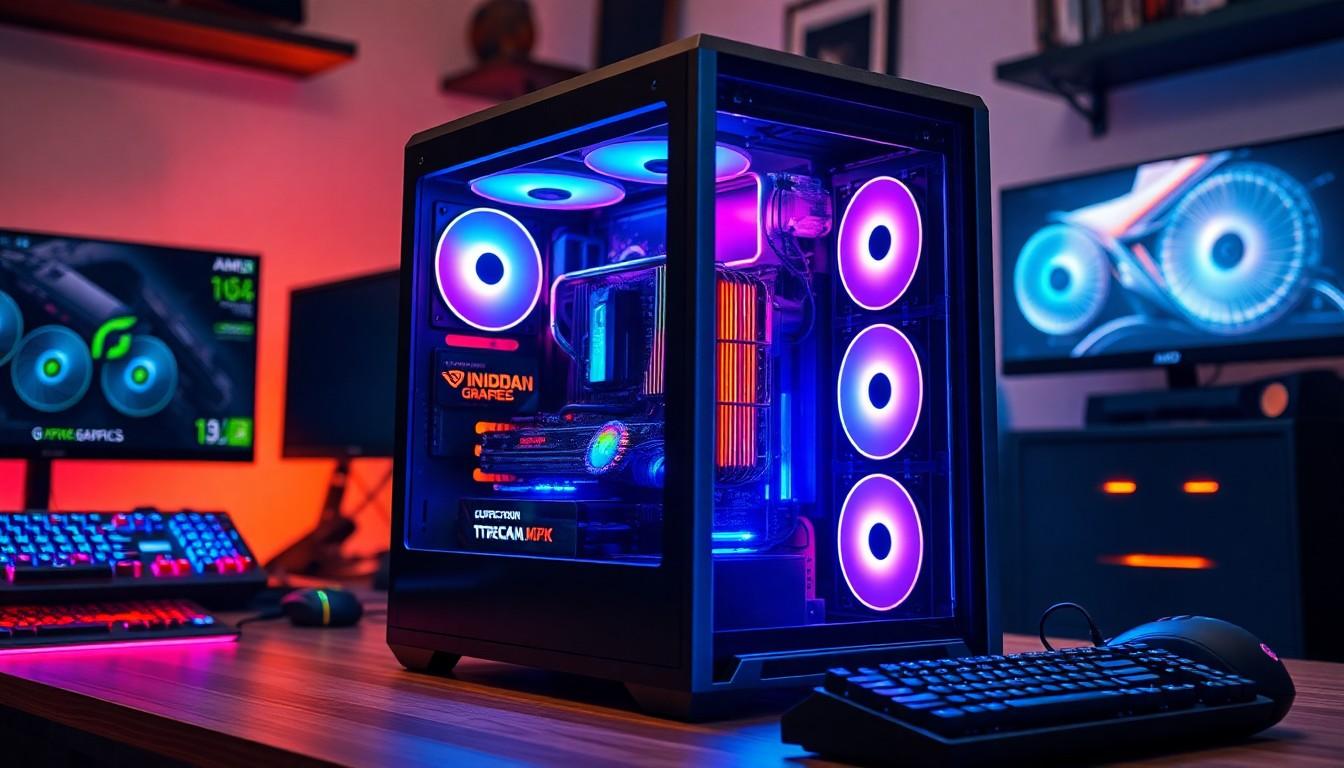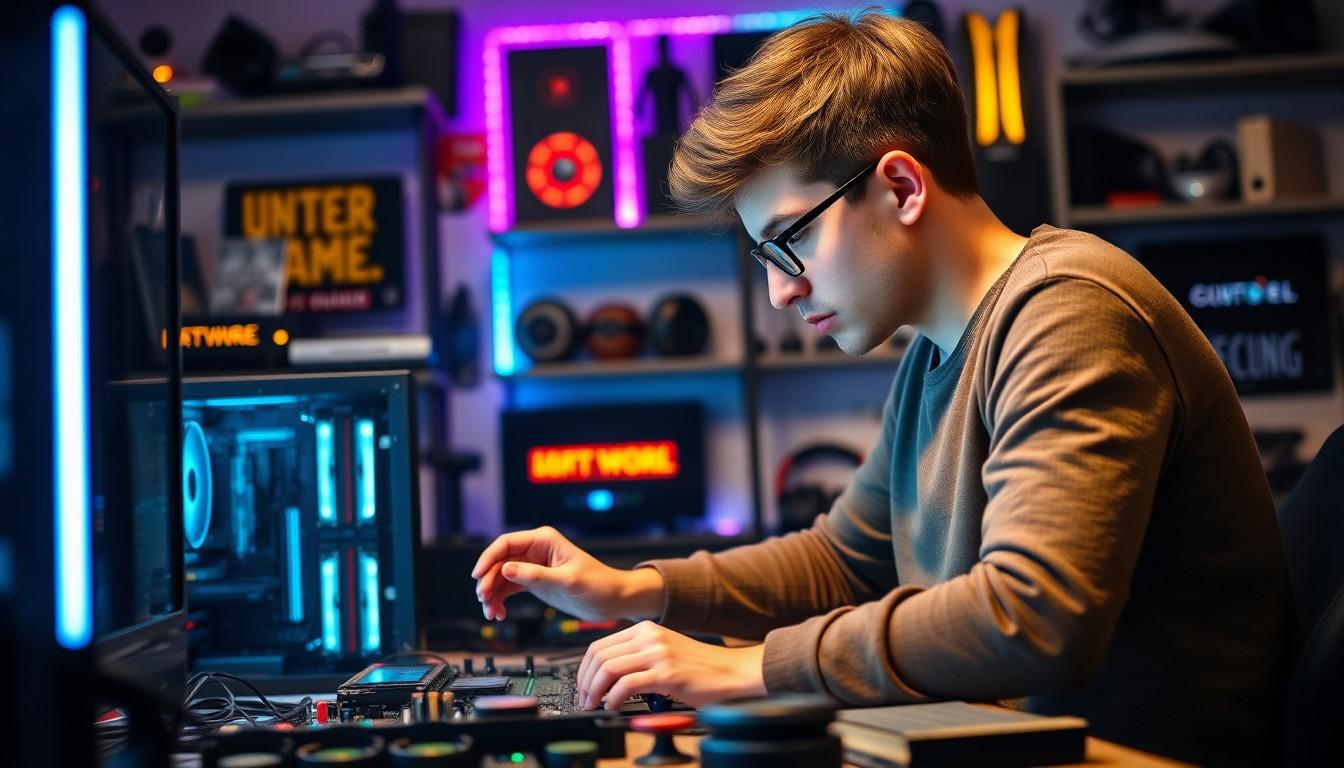Building a gaming PC isn’t just a hobby; it’s a rite of passage for any serious gamer. Forget about the pre-built systems that come with a side of disappointment. Crafting your own rig gives you the power to unleash gaming performance like never before. Imagine playing the latest titles with graphics so stunning they’ll make your friends question their life choices.
Building a Gaming PC
Building a gaming PC provides significant advantages for serious gamers. Customizing components allows for tailored performance and aesthetics. Improved graphics cards deliver higher frame rates and enhanced visuals during gameplay.
Choosing the right CPU plays a critical role in optimizing performance. Powerful processors support demanding games and multitasking. Memory options, like RAM, contribute to smooth gameplay and efficient loading times.
Selecting the appropriate motherboard is essential for compatibility. A good motherboard integrates seamless communication between components. Connectivity options, such as USB ports and slots, influence future upgrades and peripherals.
Storage solutions impact loading speeds and game access. Solid-state drives (SSDs) offer faster read and write speeds than traditional hard drives. Combining SSDs with HDDs provides a balance of speed and capacity.
Cooling systems maintain optimal temperatures during intense gaming sessions. Air coolers and liquid cooling options each have unique benefits. Investing in effective cooling prevents hardware damage and ensures longevity.
Power supply units (PSUs) play a crucial role in system stability. Sufficient wattage ensures components receive adequate power. Modularity adds flexibility, allowing tailored cable management for enhanced airflow.
Aesthetic choice influences the overall appearance of the build. RGB lighting and case designs enhance visual appeal. Personalization reflects individual style and makes the system stand out.
Building a gaming PC not only delivers superior performance but also fosters a rewarding experience. Gamers gain knowledge and understanding of their systems. This experience ultimately enhances their gaming journey.
Essential Components Needed
Building a gaming PC involves selecting several essential components, each contributing to system performance and stability. Prioritize these elements for an optimal gaming experience.
CPU Selection
Choosing the right CPU significantly impacts overall performance. Select a processor that matches gaming needs and budget. Popular options include AMD Ryzen and Intel Core series. Ryzen offers multi-threading capabilities, enhancing performance in demanding tasks, while Intel processors excel in single-threaded performance. Balance cores and clock speeds based on preferred games and tools.
GPU Selection
The GPU determines the visual quality and frame rates in games. Prioritize a powerful graphics card for an immersive experience. NVIDIA and AMD provide excellent options for various budgets. Consider factors like VRAM and ray tracing support. Research benchmarks for preferred games, ensuring the selected GPU meets specific performance requirements.
Motherboard Compatibility
Compatibility between the CPU and motherboard is crucial. Ensure the motherboard supports the chosen processor’s socket type. Quality motherboards offer features like PCIe slots for GPUs and sufficient RAM slots. Check for future upgrade possibilities, including multiple GPU support and connectivity options like USB ports and Ethernet.
RAM and Storage Options
RAM plays a vital role in multitasking and gameplay smoothness. For gaming, 16 GB is generally recommended, but 32 GB benefits resource-heavy applications. Speed also matters; faster RAM can enhance performance in specific scenarios. Solid-state drives (SSDs) provide quicker load times than traditional hard drives. Include an SSD for the operating system and favorite games while using hard drives for additional storage.
Step-by-Step Guide to Building a Gaming PC
Building a gaming PC involves several key steps. Each step requires attention to detail and careful planning.
Planning Your Build
Choosing components forms the foundation of a successful gaming PC. Identify the budget first, as this affects every component selection. Assess the gaming performance desired, which guides CPU and GPU choices. Research compatible motherboards to support these processors. Determine the memory options, with 16 GB as a standard for gaming. Consider storage preferences by opting for an SSD to speed up load times. Effective planning ensures all parts work harmoniously together.
Assembling the Components
Begin assembling by preparing a clean workspace. Gather tools like a screwdriver for efficient building. Install the CPU and RAM onto the motherboard before placing it in the case. Attach the power supply to ensure proper power flow to all components. Next, install the GPU into the appropriate PCIe slot. Include storage drives, ensuring they connect securely. Following manufacturer guidelines simplifies the assembly process and minimizes errors.
Installing the Operating System
Once assembly completes, it’s time to install the operating system. Prepare a USB drive with the desired OS, such as Windows or Linux. Boot the system from this USB drive, allowing the installation process to commence. Follow on-screen prompts to select partitions and configure settings. After installation completes, adjust system preferences to optimize performance. Update drivers to ensure all hardware functions correctly.
Optimization and Maintenance Tips
Optimizing and maintaining a gaming PC enhances performance and longevity. Regular attention to these areas ensures the system runs smoothly.
Overclocking Your Hardware
Overclocking can significantly boost gaming performance. Increase the CPU and GPU clock speeds beyond manufacturer specifications for enhanced frame rates and responsiveness. Monitoring temperatures is crucial during the process. Use adequate cooling solutions like aftermarket coolers to prevent overheating. Stability tests play a vital role in ensuring the system remains reliable under higher loads. Software tools like MSI Afterburner allow users to tweak performance settings easily. Proceed with caution, as excessive overclocking may lead to hardware damage.
Keeping Your PC Clean
Maintaining a clean gaming PC contributes to optimal performance. Dust buildup inside the case can restrict airflow and hinder cooling efficiency. Use compressed air to remove dust from fans, heatsinks, and components monthly. Regularly check cable management to minimize clutter, which improves airflow and aesthetics. Consider replacing thermal paste on the CPU every couple of years to maintain effective heat transfer. Establish a routine for cleaning, as proactive measures extend the lifespan of components and ensure peak performance during gaming sessions.
Creativity and Passion
Building a gaming PC is more than just a technical endeavor; it’s a chance for gamers to create a machine tailored to their unique preferences and gameplay styles. This journey not only enhances gaming performance but also deepens their understanding of computer systems.
By selecting the right components and following a structured assembly process, they can achieve impressive results that outshine pre-built options. With the right care and maintenance, a custom rig can provide lasting performance and satisfaction.
Ultimately, it’s about personalizing the gaming experience and taking pride in a build that reflects individual creativity and passion for gaming.

